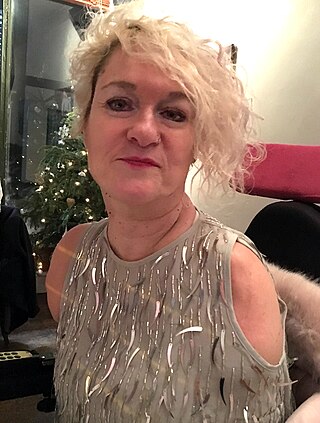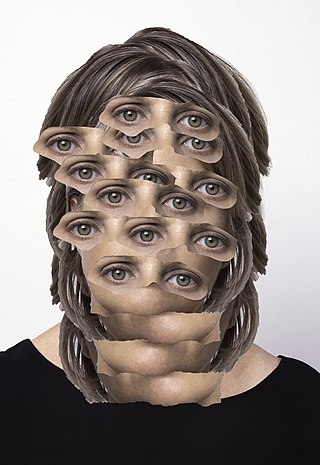Related Research Articles

Alison Lapper MBE is a British artist. She is the subject of the sculpture Alison Lapper Pregnant, which was displayed on the fourth plinth in Trafalgar Square from September 2005 until late 2007. She and her late son Parys featured in the BBC docuseries Child of Our Time.

Judith Scott was an American fiber sculptor. She was deaf and had Down Syndrome. She was internationally renowned for her art. In 1987, Judith was enrolled at the Creative Growth Art Center in Oakland, California, which supports people with developmental disabilities. There, Judith discovered her passion and talent for abstract fiber art, and she was able to communicate in a new form. An account of Scott's life, Entwined: Sisters and Secrets in the Silent World of Artist Judith Scott, was written by her twin sister, Joyce Wallace Scott, and was published in 2016.
Disability studies is an academic discipline that examines the meaning, nature, and consequences of disability. Initially, the field focused on the division between "impairment" and "disability", where impairment was an impairment of an individual's mind or body, while disability was considered a social construct. This premise gave rise to two distinct models of disability: the social and medical models of disability. In 1999 the social model was universally accepted as the model preferred by the field. However, in recent years, the division between the social and medical models has been challenged. Additionally, there has been an increased focus on interdisciplinary research. For example, recent investigations suggest using "cross-sectional markers of stratification" may help provide new insights on the non-random distribution of risk factors capable of acerbating disablement processes.
Rites was a Canadian magazine, published for gay, lesbian, bisexual, and transgender communities in Canada from 1984 to 1992.
Bonnie Sherr Klein is a feminist filmmaker, author and disability rights activist.
Kiss and Tell is a Vancouver, British Columbia based performance and artist collective whose work is concerned with lesbian sexuality. In 1990, collective members Persimmon Blackbridge, Lizard Jones and Susan Stewart used the intense debates within the queer community around sexual practice in the early 1990s to create the photographic exhibition Drawing the Line. Their photographs depicted a continuum of lesbian sexual practice ranging from kissing to whipping, bondage, and voyeurism. The project encouraged gallery viewers to comment on what they saw and how it made them feel by writing directly on the walls around the prints; allowing the viewer to "draw the line" and examine their ideas and beliefs about different sexual behaviors. “Drawing the Line” was made in response to the “porn wars” of the late 80’s-the feminist debate of if female sexual imagery was more oppressive to women, or if it was empowering to women. Kiss and Tell’s work explicitly embraced depictions of female sexuality, and encouraged the conversation between anti-porn feminists and sex positive feminists. The art was controversial, even more so as it was released in the era of the Red Hot Video Store bombings. The collective displayed their work to point out the double standard in which artists exploring politics and sexuality are “cause for alarm” and yet adult films and magazines that are much more explicit are of no concern. This show was about desensitizing the view of queer sex and relationships. It intended to make lesbian relationships just as visible as straight relationships. Through the intimate exploration of queer bodies, The Kiss and Tell collective gave space for lesbians to perform and share their experiences. The show traveled widely in Canada and the United States in the 1990s, as well as showing in Australia and the Netherlands. In the summer of 2015 Kiss and Tell had redisplayed and revisited their exhibition “Drawing the Line.” This was featured at the Vancouver Queer Arts Festival in celebration of the work’s 25th anniversary, and was the first time in 13 years that it had been displayed.
Sarindar Dhaliwal is a Canadian multi-media artist, based in Toronto.
Martha Wilson is an American feminist performance artist and the founding director of Franklin Furnace Archive art organization. Over the past four decades she has developed and "created innovative photographic and video works that explore her female subjectivity through role-playing, costume transformation, and 'invasions' of other peoples personas". She is a recipient of two National Endowment for the Arts fellowships, a New York Foundation for the Arts fellowship, and an Obie Award and a Bessie Award for commitment to artists’ freedom of expression. She is represented by P•P•O•W gallery in New York City.
Carrie Moyer is an American painter and writer living in Brooklyn, New York. Moyer's paintings and public art projects have been exhibited both in the US and Europe since the early 1990s, and she is best known for her 17-year agitprop project, Dyke Action Machine! with photographer Sue Schaffner. Moyer's work has been shown at the Whitney Biennial, the Museum of Arts and Design, and the Tang Museum, and is held in the permanent collections of the Metropolitan Museum of Art. She serves as the director of the graduate MFA program at Hunter College, and has contributed writing to anthologies and publications like The Brooklyn Rail and Artforum.
Laura Aguilar was an American photographer. She was born with auditory dyslexia and attributed her start in photography to her brother, who showed her how to develop in dark rooms. She was mostly self-taught, although she took some photography courses at East Los Angeles College, where her second solo exhibition, Laura Aguilar: Show and Tell, was held. Aguilar used visual art to bring forth marginalized identities, especially within the LA Queer scene and Latinx communities. Before the term Intersectionality was used commonly, Aguilar captured the largely invisible identities of large bodied, queer, working-class, brown people in the form of portraits. Often using her naked body as a subject, she used photography to empower herself and her inner struggles to reclaim her own identity as “Laura”- a lesbian, fat, disabled, and brown person. Although work on Chicana/os is limited, Aguilar has become an essential figure in Chicano art history and is often regarded as an early "pioneer of intersectional feminism” for her outright and uncensored work. Some of her most well-known works are Three Eagles Flying, The Plush Pony Series, and Nature Self Portraits. Aguilar has been noted for her collaboration with cultural scholars such as Yvonne Yarbo-Berjano and receiving inspiration from other artists like Judy Dater. She was well known for her portraits, mostly of herself, and also focused upon people in marginalized communities, including LGBT and Latino subjects, self-love, and social stigma of obesity.
Sandra Brewster is a Canadian visual artist based in Toronto. Her work is multidisciplinary in nature, and deals with notions of identity, representation and memory; centering Black presence in Canada.
The VIVA Awards are $15,000 prizes, granted annually to British Columbian mid-career artists chosen for "outstanding achievement and commitment" by the Jack and Doris Shadbolt Foundation. The awards are presented by the Shadbolt Foundation in conjunction with the Alvin Balkind Curator's Prize.
Xiaojing Yan is a contemporary Chinese Canadian artist known for her work in sculpture, installation and public art.
Lorna Boschman (1955) is a Canadian Queer media artist, film maker, curator, educator, editor, and camera operator working with themes such as sexual identity, body image, social justice, (dis)ability, cancer, abuse, health, and self-advocacy.

Elizabeth Zvonar is a Canadian contemporary artist who works primarily with mixed-media collage and sculpture based in Vancouver, British Columbia, Canada. She is currently represented by Daniel Faria Gallery, Toronto, Ontario, Canada.
Evelyn Roth is a Canadian born interdisciplinary artist who has worked across the arts in textiles, sculpture, performance, dance and interactive fabric arts. Specialising in environmentally sensitive events, festivals, school programs and art gallery exhibits. Roth is based in the town of Maslin Beach, on South Australia's Fleurieu Peninsula.
Katherine Boyer is a Métis artist, whose multidisciplinary practice focuses primarily on the mediums of sculpture, printmaking and beadwork. She was born and raised in Regina, Saskatchewan, but currently resides in Winnipeg, Manitoba—a location that has had a direct influence on her current artistic practice.
Cindy Mochizuki is a multimedia Japanese Canadian artist based in Vancouver, British Columbia. In her drawings, installations, performance, and video works created through community-engaged and location-specific research projects, Mochizuki explores how historical and family memories are passed down in the form of narratives, folktales, rituals and archives. Mochizuki's works have been exhibited in multiple countries including Japan, the United States, and Canada. Mochizuki received MFA in Interdisciplinary Studies from the School For Contemporary Arts at Simon Fraser University in 2006. She received Vancouver's Mayor's Arts Award in New Media and Film in 2015 and the VIVA and Max Wyman awards in 2020.
Mari Katayama is a Japanese multimedia artist known for her sculpture and photography work. Her work focuses on themes such as body image, identity, and her experience as an amputee.
Eli Clare is an American writer, activist, educator, and speaker. His work focuses on queer, transgender, and disability issues. Clare was one of the first scholars to popularize the bodymind concept.
References
- 1 2 Inductee: Persimmon Blackbridge. The ArQuives: Canada's LGBTQ2+ Archives.
- 1 2 SHAMELESS: The ART of Disability, National Film Board of Canada, retrieved 2021-04-05
- ↑ "Persimmon Blackbridge – BODIES IN TRANSLATION". 5 July 2020. Retrieved 2022-03-12.
- ↑ "20 Questions: Persimmon Blackbridge" Archived 2013-02-21 at archive.today . Philadelphia City Paper , December 18, 1997.
- 1 2 3 "Persimmon Blackbridge". section15.ca, May 30, 2008.
- ↑ "The Jack and Doris Shadbolt Foundation For the Visual Arts :: VIVA Award Winners". www.shadboltfoundation.org. Archived from the original on 4 March 2016. Retrieved 21 September 2016.
- ↑ "Doing Time | City of Surrey". www.surrey.ca. 2019-12-11. Retrieved 2023-04-29.
- ↑ Hasselfelt, Karen, ed. (1989). Doing Time. Surrey, BC: Surrey Art Gallery.
- ↑ Diamond, Sara (Fall 1984). "Still Sane". Fuse: 30–35.
- ↑ Rosenberg, Ann (30 May 1991). "Drawing out city's finest". Vancouver Sun.
- ↑ "Constructed Identities at Âjagemô". Canada Council for the Arts. Retrieved 2021-04-05.
- 1 2 Alison, Kafer (2013). Feminist, queer, crip. Indiana University Press. ISBN 978-0-253-00941-8. OCLC 1136415788.
- 1 2 Millett-Gallant, Ann (2019), "Crip aesthetics in the work of Persimmon Blackbridge", The Routledge Handbook of Disability Arts, Culture, and Media, Routledge international handbooks (1st ed.), New York: Routledge, pp. 218–226, doi:10.4324/9781351254687-17, ISBN 978-1-351-25468-7, S2CID 192872286 , retrieved 2021-04-05
- ↑ "8 Things Everyone Needs to Know About Art and Disability". canadianart.ca. Retrieved 2021-04-05.
- ↑ "Emily Carr University Federated Login - Stale Request". idp.ecuad.ca. Retrieved 2021-03-31.
- 1 2 art (2019-09-20). "Art and Activism: Q&A with Persimmon Blackbridge". AGGV magazine. Retrieved 2021-04-05.
- ↑ "Sunnybrook: A True Story with Lies…". Quill and Quire. 2004-03-05. Retrieved 2021-03-10.
- ↑ "Prozac Highway". Metapsychology Online Reviews. Retrieved 2021-04-05.
- ↑ "Persimmon Blackbridge – BODIES IN TRANSLATION". 5 July 2020. Retrieved 2021-04-05.